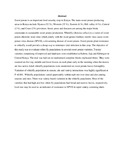Response Of Sweet Potato Varieties For White Flies Resistance

View/
Date
2011Author
Muturi, P. W.
Mburu, M. W. K.
Mwololo, J. K.
Ateka, E. M.
Njeru, R. W.
Njoroge, K.
Type
PresentationLanguage
enMetadata
Show full item recordAbstract
Sweet potato is an important food security crop in Kenya. The main sweet potato producing
areas in Kenya include Nyanza (52 %), Western (35 %), Eastern (6 %), Rift valley (4 %), Central
(2 %), and Coast (2%) provinces. Insect pests and diseases are among the major biotic
constraints to sustainable sweet potato production. Whitefly (Bemisia tabaci) is a vector of sweet
potato chlorotic stunt virus which jointly with the sweet potato feathery mottle virus cause sweet
potato virus disease (SPVD), a devastating disease of sweet potato. Sweet potato plant resistance
to whitefly would provide a cheap way to minimize viral infection in this crop. The objective of
this study was to evaluate white fly populations in several sweet potato varieties. Twenty
varieties comprising of improved and landraces were established at Kabete, Juja and Kibirigwi in
Central Kenya. The trial was laid out in randomised complete blocks replicated thrice. They were
counted on five top, middle and lower leaves on each plant early in the morning when the insects
are less active.Adult whitefly populations were monitored on sweet potato leaves fortnightly.
Variation of whitefly population in season, site and variety interactions was highly significant at
P <0.001. Whitefly populations varied appreciably within each site over time and also among
seasons and sites. There was variety based variation in the whitefly population. Most of the
varieties that had high and low white fly populations had broad and narrow leaves, respectively.
Leaf size may be used as an indicator of resistance to SPVD in rapid variety screening trials.
